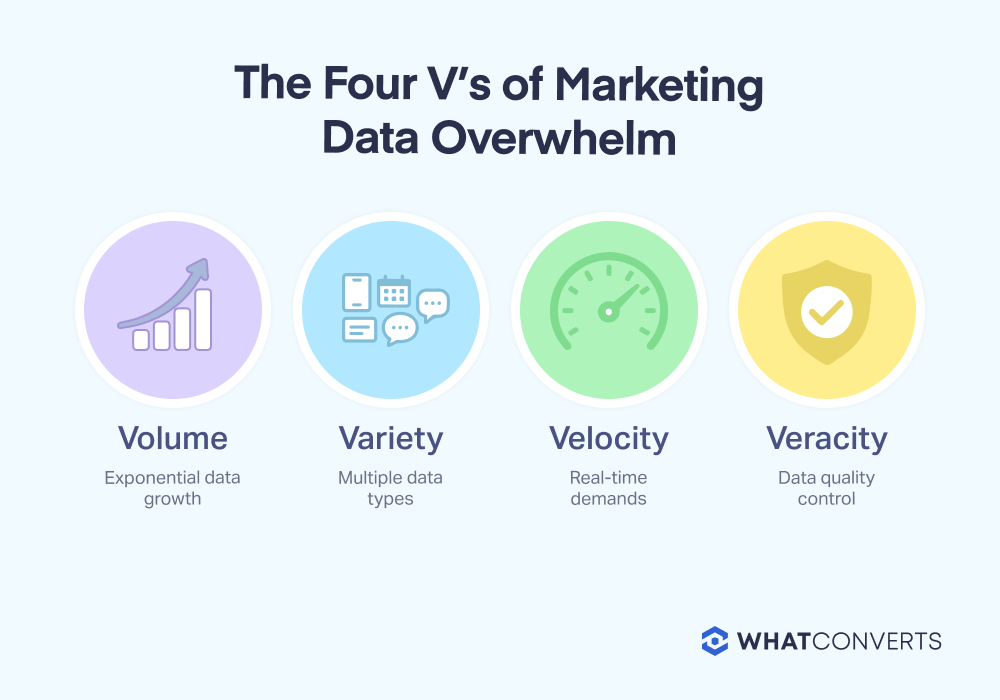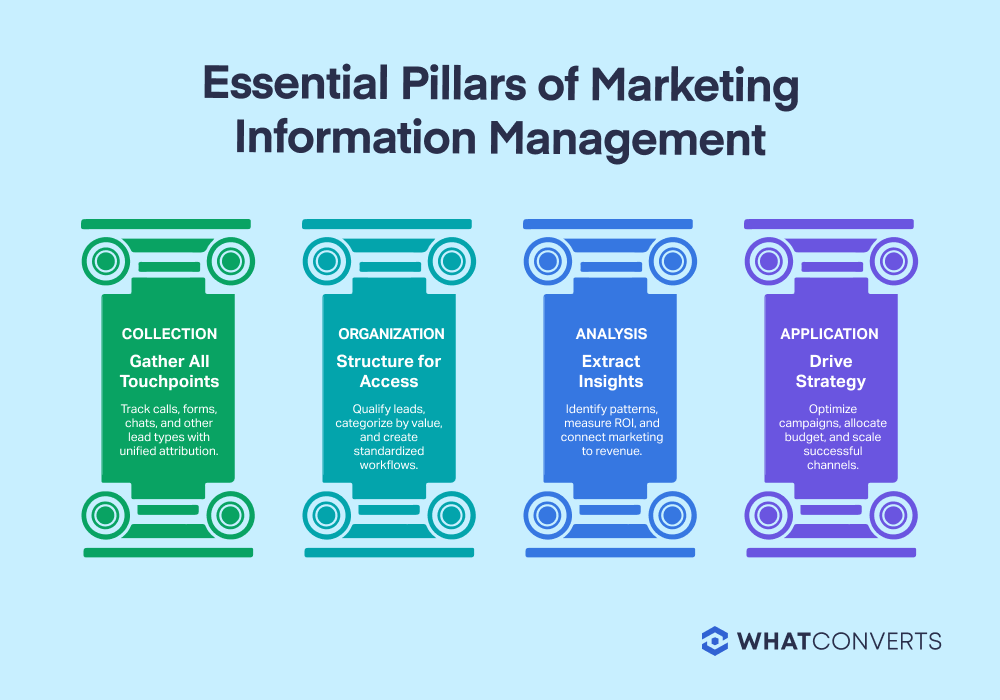
Your marketing generates more data than ever, yet most teams can't answer basic questions: Which campaigns drive qualified leads? What's our true marketing ROI?
This is the modern marketing paradox—data-rich but insight-poor. Multiple tools create fragmented information silos where valuable intelligence gets lost in the noise. Without effective marketing information management, teams make critical decisions based on incomplete data.
The solution isn't collecting more data; it's transforming how you organize, analyze, and apply the data you already have.
The Marketing Data Crisis

Volume
Data volume has exploded exponentially. Marketing teams rely on multiple different tools, each generating its own set of metrics and reports. From Google Analytics pageviews to Facebook ad impressions, from email open rates to call tracking minutes, the sheer amount of data can overwhelm even experienced marketers.
Variety
The ever-widening variety of data types adds another layer of complexity. Modern marketing generates diverse data: phone calls, form submissions, chat conversations, eCommerce transactions, social media interactions, and email responses. Each requires different tracking methods and analysis approaches, making it difficult to create a unified view of performance without the right tools.
Read More: Better > More: Agency Segments Leads by Type, Grows Volume 220%
Velocity
As data streams in faster than teams can process it, the demand for real-time insights is greater than ever. Marketing campaigns launch, evolve, and conclude rapidly. Budget decisions can't wait for monthly reports. Teams need immediate access to performance data to optimize campaigns while they're running, not after they've ended.
Veracity
When not all clicks, conversions, and leads are created equal, ensuring the veracity of your data is an absolute must. Spam inquiries, duplicate submissions, and unqualified prospects can skew performance metrics and lead to poor optimization decisions. Without systems to distinguish valuable prospects from noise, marketers risk wasting budget on campaigns that generate high lead volume but low lead quality.
These challenges create attribution gaps that make it nearly impossible to see which campaigns drive valuable leads. When your call tracking tool shows different numbers than your form analytics, and your CRM reports don't match your ad platform conversions, strategic decision-making becomes guesswork. Effective marketing information management solves these problems by creating unified systems that organize, qualify, and connect all marketing data to business outcomes.
Building a Marketing Information Architecture
Good marketing information management starts with a unified architecture that transforms chaotic data streams into strategic intelligence. Building this architecture involves strategic decisions about what to measure, how to organize it, and how teams will access the insights they need.
Defining Essential Marketing Metrics
The metrics you choose need to offer an accurate reflection of your marketing campaigns’ success (or lack thereof). Vanity metrics like clicks and impressions don’t reliably reflect the actual actions and outcomes that are taking place underneath the surface.
Move deeper to establish a real, actionable data foundation that focuses on business-impact indicators. Prioritize KPIs that connect directly to revenue—metrics like qualified leads generated, sales value driven, and cost per acquisition. When you can measure and compare your campaigns, keywords, and ads using these data points, you start to get clearer insights into which marketing activities actually drive business growth.
Creating a Unified Data Taxonomy
Once you’re collecting the right data, you need to organize it so that it’s actually usable for gaining insights and making data-backed business decisions. Establish consistent categorization systems across all marketing channels and lead types. Whether a prospect converts via phone call, web form, or chat, they should be tagged with the same campaign identifiers, source attributions, and qualification criteria. This standardization will let you perform accurate cross-channel analysis and will eliminate data reconciliation headaches.
Read More: Data-Driven Marketing: Agency's In the Weeds Methods Win 7X ROI
Establishing Clear Information Flows
A solid data taxonomy helps you understand where your data ends up. It’s also important to understand how that data moves through your marketing and sales systems before it winds up in your database.
Map how data moves from initial lead capture through qualification, nurture, and conversion. Every touchpoint in the customer journey should be tracked, and each new data point from a particular lead’s journey should be stored with the rest of that specific lead’s data. You need a good system for importing and updating new information and ensuring those updates are automatically assigned to the correct lead ID.
It’s only by storing your marketing data on a lead-by-lead basis that you can trace each of these touchpoints, and ultimately that lead’s conversion into a paying customer, back to the original marketing campaign that deserves credit for capturing that lead.
Designing Decision-Driving Dashboards
Once you understand how data flows through your systems, you need to make that information accessible and actionable. Build reports that answer specific business questions rather than simply displaying available data. Focus on actionable insights: which campaigns drive the highest-value leads, which keywords generate qualified prospects, and which channels deliver the best ROI. Effective dashboards eliminate confusion and guide optimization decisions.
A unified lead tracking platform becomes the foundation of this architecture, consolidating all conversion data—calls, forms, chats, and eCommerce transactions—into a single system with consistent attribution across channels.
The Four Pillars of Marketing Information Management
Collection: Gathering the Right Data from Multiple Sources
Comprehensive data collection captures every interaction across all marketing channels with consistent attribution. This means tracking phone calls from Google Ads with the same level of detail as form submissions from organic search or chat conversations from social media campaigns.
Automated data capture eliminates manual entry errors and ensures no leads slip through tracking gaps. A single tracking script can monitor all conversion types while maintaining complete customer journey visibility from first touch to final conversion.
Organization: Structuring Information for Accessibility and Relevance
Raw lead data becomes valuable when properly organized and qualified. This involves separating genuine prospects from spam inquiries, categorizing leads by quality and potential value, and creating standardized workflows for lead evaluation.
Effective organization systems allow different team members to access relevant information quickly. Sales teams need qualified lead details and conversation history. Marketing managers require campaign performance summaries and attribution data. Executives want ROI overviews and growth trend analysis.
Analysis: Transforming Raw Data into Actionable Insights
Analysis moves beyond basic reporting to identify patterns, trends, and optimization opportunities. This includes assessing which campaigns consistently generate qualified prospects, understanding typical conversion paths, and calculating true marketing ROI based on actual sales outcomes.
Advanced analysis connects marketing activities to business results by tracking leads through the entire sales cycle. When you can see that specific keywords or campaigns not only generate leads but also produce closed sales, budget allocation decisions become straightforward.
Application: Implementing Insights into Marketing Strategy
The ultimate goal is turning insights into action. Use lead quality data to refine campaign targeting, shift budget toward highest-performing channels, and eliminate wasteful spending on low-value activities.
Application also involves creating feedback loops where sales outcomes inform marketing optimization. When qualified leads convert to customers, that intelligence should flow back to marketing systems to improve future campaign targeting and bidding strategies.
From Tracking to Intelligence: The Evolution of Marketing Data
Traditional marketing analytics focused on counting activities: clicks, impressions, form submissions, and phone calls. Modern marketing information management moves beyond basic counting to measure business impact and predict future outcomes.
Connecting Marketing to Revenue
The most significant evolution involves closing the loop between marketing activities and actual sales results. Instead of stopping at lead generation, advanced systems track prospects through the entire sales cycle, connecting specific campaigns and keywords to closed deals and revenue generation.
Lead Scoring and Intelligence
Automated lead qualification transforms how teams prioritize follow-up activities. By analyzing behavioral signals, demographic information, and interaction patterns, intelligent systems can predict which leads are most likely to convert, allowing sales teams to focus their efforts on the highest-potential prospects.
Predictive Optimization
Machine learning algorithms can analyze historical performance data to predict which marketing activities will generate the best results. This enables proactive optimization rather than reactive adjustments based on past performance.
When integrated with ad platforms, qualified lead data can automatically train bidding algorithms to target similar high-value prospects, creating a continuous improvement cycle that enhances campaign performance over time.
Best Practices for Marketing Information Management Success
Focus on Lead Quality Over Quantity
Measure campaigns by the value of leads generated, not just volume. A campaign that generates ten qualified prospects is more valuable than one that produces 100 unqualified inquiries.
Maintain Data Hygiene
Implement regular processes for identifying and removing duplicate leads, spam submissions, and outdated information. Clean data produces more accurate insights and better optimization decisions.
Create Cross-Functional Alignment
Ensure marketing and sales teams agree on lead definitions, qualification criteria, and handoff processes. Misalignment creates friction and reduces the effectiveness of lead generation efforts.
Establish Regular Review Cycles
Schedule monthly and quarterly analysis sessions to identify trends, spot opportunities, and adjust strategies based on performance data.
Turning Information into Impact
Superior marketing information management creates competitive advantages that compound over time. Teams with unified tracking, quality-focused metrics, and actionable reporting make faster, more accurate optimization decisions. They identify high-performing campaigns earlier, eliminate wasteful spending more quickly, and scale successful strategies with greater confidence.
The transformation from data chaos to strategic clarity requires commitment to comprehensive tracking, disciplined analysis, and consistent application of insights. But the payoff—improved ROI, better lead quality, and accelerated growth—makes the investment worthwhile.
Ready to transform your marketing information management? Start your free 14-day WhatConverts trial or book a demo today.
Get a FREE presentation of WhatConverts
One of our marketing experts will give you a full presentation of how WhatConverts can help you grow your business.
Schedule a Demo
Grow your business with WhatConverts






